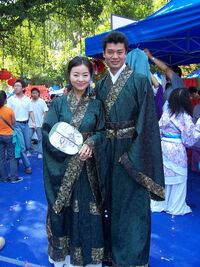| 英人 Yīngrén Indralans | |
|---|---|

| |
| Total population | 150 million (approx) |
| Regions with significant populations |
Indrala 90 million Dalibor 10 million Jinlian 60 million |
| Language | Indralan |
| Religion | Gao-Showan Religions: 80%
Other 5% |
| Related ethnic groups | Đinh |
Indralan people are an ethnic and national group native to Indrala, who speak the Indralan language. Closely related to other Gao-Showa people, the ethnic and national identity dates back as far as the 14th century and the United Indralan Commonwealth.
History[]
The Indralan people are believed to have descended from the original proto-Gao-Showans who crossed from their homelands in Dovani to the island of Dalibor and later to the island of Indrala. The Indralan identity began to develop in the Commonwealth period, known as the Indralan Golden Age, when an explosion of arts and culture as experienced. Several national heroes existed in this time and almost all of Indrala's most famous classical paintings and novels were created.

|
State of Indrala
瑩大磖國 (Indralan) | |
| History | Historic Events: Blue Lotus Rebellion - Dawei Miracle - Southern Hemisphere War - War of Independence - Yu Restoration Historic Periods: Mesing - Gemu-Teng - Qin - Talmu - Great Xinhan - United Commonwealth - Alorian Protectorate - Gongchang - Mingzhi - He - Yu - Wen Important Sites: Heavenly City - Mengmai - Temple of Ten Thousand Bidars | |
| Geography | Natural Features: Anle Range - Baitian Valley - Fehua Bay - Ma-Gan River - Tebie Desert - Shengo Rock Provinces: Han - Jiaozhi - Min - Anle - Shu | |
| Politics | Prime Minister of Yingdala - Legislative Council Political Parties: | |
| Demographics | Ethnic Groups: Indralan - Kyo-Indralans - Dinh - Bianjie - Kunihito Religion: Jienism - Guidao - Daenism (Mazdâyanâ, Zenshō) - Seodongyo | |
| Culture | Monarchy - Nobility - Sport | |
| Economy | Agriculture - Banking - Caizu - Industry - Jiaozhi Miracle - Mining - Tourism | |

|
Gao-Showans | |
| Peoples | Central: Kunihito • Sekowans • Kyo | Northern: Utari • Welang | Southern: Indralans • Đinh • Phra • Suman | Western: Tukarese • Mu-Tze • Bianjie | |
| Languages | Gao-Indralan: Kunikata • Sekowan • Indralan • Đinh • Phra • Suman• Utari | Jelbo-Tukaric: Panmuan • Bianjie | Other: Kyo | |
| Regions | Dovani • Seleya • Gao-Soto • Sekowo • Dankuk • Indrala • Tukarali • Jinlian • Dalibor • Great North Dovani Plain • Kalistan • Bianjie • Hanzen | |
| History | Empire of Gao-Soto • Kingdom of Sekowo • History of Sekowo • History of Indrala • History of Dranland • History of Tukarali • Great Sekowian War • Southern Hemisphere War | |
| Religion | Gao-Showan Religions • Daenism • Mazdâyanâ • Zenshō • Kamism • Guidao • Jienism • Kanzo | |
